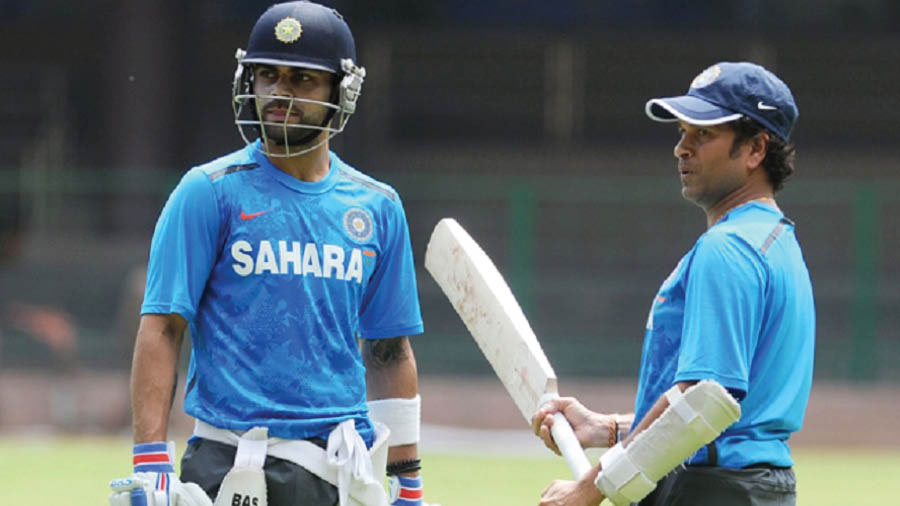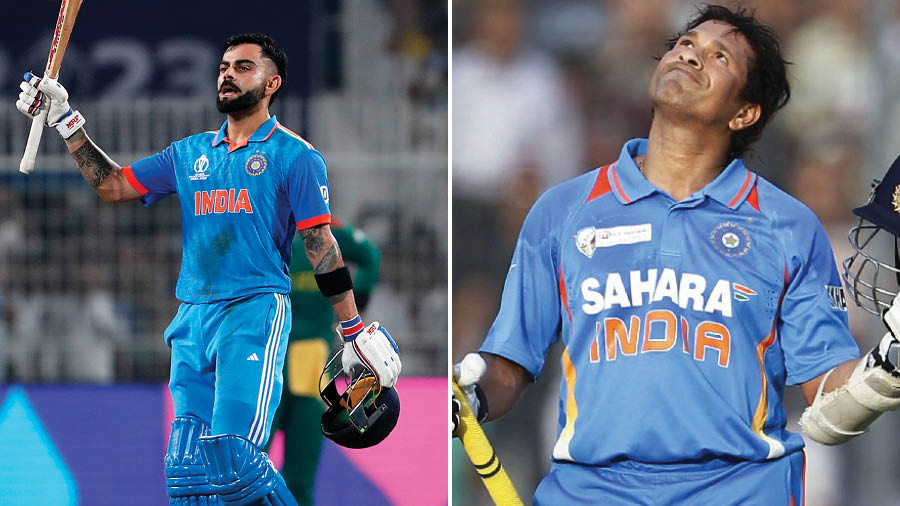When Sachin Tendulkar reached his 49th and final ODI century on March 16, 2012, against Bangladesh in Mirpur, there was barely a smile on Tendulkar’s face. There was no flourish of the bat, no spring in his step, not even a punch of the air. Nothing remotely resembling the delight coursing through his fans and teammates who had witnessed history. For Tendulkar, the overwhelming emotion was relief. Not only had he become the first batter to hit 49 ODI tons, but he had also brought up his 100th international hundred, a feat yet to be matched. Relief was the abiding feeling once more on November 5, 2023, this time for Virat Kohli, when he completed his 49th ODI century (79th overall in international cricket) against South Africa at the Eden Gardens to go level with his idol on his 35th birthday.
Even though neither Tendulkar nor Kohli’s celebrations matched the enormity of their achievements, it does not undermine the fact that only two men on the face of this planet know what it is like to have 49 ODI centuries to their name. Kohli, of course, has the chance to better the Master Blaster, and do so at the ongoing ICC Men’s Cricket World Cup. With India in the semi-finals, Kohli should have at least two more chances to go from equalling Tendulkar to eclipsing him. The tantalising prospect of Kohli going past Tendulkar in the latter’s backyard at the Wankhede Stadium in Mumbai (where India will play the first semi-final) remains a distinct possibility. But before more history is made by India’s run machine, My Kolkata has done some number crunching to make sense of the history that has already unfolded. With Tendulkar and Kohli locked at 49 ODI centuries, whose hundreds have had the greater impact? The process to find the answer should be even more interesting than the mind-boggling stat of Kohli reaching 49 centuries in 174 fewer innings than Tendulkar.
Nervous 90s got the better of Tendulkar 18 times, 12 more than Kohli
Before decoding the serious business of 98 centuries and their relative impact, here is an overview of the basic numbers behind Tendulkar and Kohli’s ODI hundreds. Tendulkar made 6,122 runs in ODI cricket as part of his centuries at an average of 180, a strike rate of 100.81 and a highest score of 200 not out. For Kohli, his ODI centuries so far have yielded him 5,913 ODI runs at an average of 197.10, a strike rate of 109.27 and a highest score of 183. While Tendulkar’s 50 to 100 conversion rate is 51 per cent, Kohli’s is considerably higher at 70 per cent. Twenty of Tendulkar’s centuries have come in India, with 29 in away or neutral venues. Twenty-three of Kohli’s centuries have come in India, with 26 in away or neutral venues. In what should come as little surprise given Kohli’s reputation as the finest chaser in ODI history, 27 of Kohli’s tons have come batting second, while the same number for Tendulkar is 17. Another expected outcome is Kohli having far more centuries as skipper given his longer tenure of leadership, with 21 hundreds to Tendulkar’s six. What is more of an eye-opener, though, is the number of times both icons have been dismissed or remained unbeaten in the 90s. It has happened on six occasions to Kohli, but, for Tendulkar, the 90s curse is real, as he came agonisingly close to adding to his hundreds no less than 18 times in ODIs.
Kohli has no ODI knockout hundreds till date, Tendulkar has seven

Tendulkar has been man of the match with 37 of his ODI century innings, three more than Kohli TT Archives
Now to the question of impact or whose centuries have mattered more. To understand this, we have created five criteria, with the idea being that whoever wins more of the criteria can legitimately claim to have won the impact contest. The first is man of the match awards, which is a decent, if not a comprehensive, indicator of a century’s match-winning impact. On this count, Tendulkar narrowly beats Kohli, with 35 of his centuries leading to man of the match awards, as compared to Kohli’s 34. The second is a mixture of longevity and consistency, for which we have taken into account the most number of calendar years with at least three ODI centuries for both batters. In this, Kohli beats Tendulkar by a slender margin of 10-8. For trivia enthusiasts, Tendulkar’s most productive century-making year in ODIs was 1998, where he made a staggering nine hundreds in a single year. Kohli’s best till date are 2017 and 2018, both of which saw him get six centuries.
With two criteria down, it is level pegging. The third concerns hundreds in knockout games (pre-quarter-finals onwards) involving three or more nations. Shockingly, Kohli does not have a single ODI hundred to his name when adjusted for the knockout filter, whereas Tendulkar has seven. To be fair to Kohli, this is somewhat skewed by the fact that apart from ICC tournaments, multinational competitions have gone down significantly in ODI cricket in Kohli’s era due to the influx of T20 internationals. The fourth parameter is the quality of opposition, for which we have factored in centuries against all 50-over world champions plus South Africa and New Zealand. Here the odds tilt in favour of Kohli with Sri Lanka and the West Indies’ relative decline in ODI cricket giving him 19 out of his 43 centuries for the category. On the other hand, Tendulkar, who played against the likes of Zimbabwe and Kenya far more frequently in ODIs, has 38 three-figure scores against the countries we have identified. This means that parity is restored at 2-2.
Lastly, as a tie-breaker, we have what is often loosely called “daddy 100s”. In other words, big 100-plus scores that are often remembered as some of the most defining knocks in the history of the game. For this, we are looking at the number of times Tendulkar and Kohli have crossed 150 or more in ODI cricket. As it turns out, both of them have done it five times! So, just as in the record books for most ODI centuries in history, it is impossible, at least for now, to split King Kohli and the Master Blaster.


